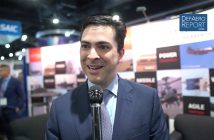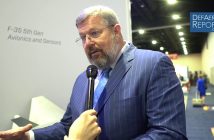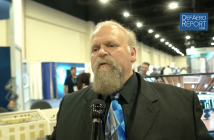Col. James “Hondo” Guerts, USAF Ret., the assistant secretary of the Navy for research, development and acquisition, discusses acquisition agility, manned and unmanned systems, supporting a larger fleet and more with Defense & Aerospace Report Editor Vago Muradian. The interview was conducted at the Navy League’s 2019 Sea Air Space conference and tradeshow outside Washington where our coverage was sponsored by GE Marine, Huntington Ingalls Industries and Leonardo DRS.
Vago Muradian: Welcome to the Defense and Aerospace Report. I’m Vago Muradian here at the Navy League’s Annual Sea Air Space Conference and Trade Show, the number one gathering of U.S. Navy leaders from around the world along with their international counterparts to talk strategy, technology, budgets, and more. Our coverage here is sponsored by GE Marine, Huntington Ingalls Industries and Leonardo DRS.
It’s our honor to talk with retired United States Air Force Colonel Hondo Geurts, who is the Assistant Secretary of the United States Navy for Research, Development and Acquisition. Hondo, it’s always an honor and a pleasure seeing you.
A/S Hondo Geurts: It’s good to see you, Vago.
Mr. Muradian: Agility is the number one message. You’re going up to the luncheon now in order to drive that message home. We were at the conference that Defense and Aerospace Report hosts along with Bank of America, and you made a fascinating comment about how sometimes you’ve got to spend a little bit more to actually save more money, and you were using the shipyard context. Hey guys, down there in the shipyards, don’t get focused on saving $5,000 if you keep a ship, for example, in the drydock for an extra week or two weeks as you’re negotiating that. As Christian Becker, the Commander of SPAWAR likes to say, a day in a shipyard is like a dog year. That’s 14 days of doing something else somewhere else.
Talk to us about that spirit of agility. How you want people to think about this, where actually spending a little bit of money actually may be saving you money over the long term. Talk to us about that mentality shift you’re trying to drive in the Navy.
A/S Geurts: Absolutely. The biggest thing I learned talking with commercial counterparts, kind of looking around the world, is it’s all about flow time.
Right now at a shipyard, the shipyard workers walk combined the equivalent of a circumvention around the earth to get to the ship. So a lot of our flow time reduction is really get efficiency. Don’t waste time traveling between buildings. Re-lay out those 100 year yards so we can, with the same amount of people deliver a lot more. We’ve got more ships coming in the inventory. We can pay to hire a bunch more folks and run a lot more contracts, or we can really drive efficiency. We’re trying to work on the efficiency side. Lots of good opportunities there.
Mr. Muradian: And how do you want the mental model to change? Whether from your acquisition folks, from your engineers. You’re trying to drive a substantive culture change which is a lot more than figuring out okay, how do we lay out better buildings. Talk to us about how you’re getting to that culture change part of this.
A/S Geurts: It’s really focusing fundamentally on affordability. So not affordability by shaving off a percentage or two. It’s where do we have fundamental costs. You’re wasting a lot of resources walking to a building, for instance. It’s a simple example, but once we have this organization all looking at fundamental costs, it’s amazing how fast the organization kind of rallies around that.
Focus on mission. If you look at what we’ve done in the Naval Aviation Enterprise, it hasn’t been a huge amount of investment in dollars. It’s been an investment in thinking, in time, and really focusing on flow. So most of our repair shops now are seeing a 50 percent increase in productivity. Not with a huge amount of investment in dollars, but sitting down and really focusing on what does it require to deliver the mission? And are we focusing all of our efforts along those lines?
Mr. Muradian: Talk to us a little bit about P2P. That’s the process that the N8 has been running, Admiral Lescher. Talk to us a little bit about P2P, how that’s working and how that’s really dramatically helping the Navy, for example, improve its naval aviation availability rate.
A/S Geurts: P2P is Perform 2 Plan. So the real focus, and it’s not just an N8 dollar thing, it’s an entire Navy, actually it’s for the TICOM Commander. So for that mission commander rallying every piece of information, every piece of data, all of our thinking, best practices, all focus on what matters to generating mission outcomes? Too many times you can get locked up in procedural, what’s a better process. Those are important. But it’s really focused primarily on what matters to the mission, and then forecasting and looking ahead to meet that mission. Here’s what I’ve got to do differently. Not just measuring, we tend to measure sometimes backward. This is really what is the performance I need to get to deliver a mission outcome for that fleet.
Mr. Muradian: Talk about agility. MQ-25 has always been the poster child. Already there is a prototype aircraft that there were four other EMD aircraft that are on-line, but it’s already at Scott Air Force Base. Obviously the commitment to fly this year. Talk to us about how you’re achieving speed and what’s next for the program, and whether or not it meets your strict and tough standards for progress.
A/S Geurts: Well, we’ll see. The Proof’s in the pudding but we do have an early airplane we’re getting in the air. And I’m always a fan of getting something operating and getting the operator, the end customer, to be able to operate it as quickly as possible. It’s the fastest way to get something he or she needs for their mission.
So if you’re looking at what we’re doing on the unmanned systems. Rapidly prototype, put it in the hands of the operator. Don’t get it perfect in the engineering space. Get it out there so that they can experiment and we can refine the requirements. And like we’ve done with Frigate, like we’ve done with MQ-25, involve industry and technology early on so that when we actually go to build it, we’ve already gone through several iterations and we aren’t just blindly following a requirement. It’s an informed requirement.
Mr. Muradian: You mentioned Frigate. That was one of the key questions down here, a lot of people saying $1.2 billion per ship is going to be a very, very tough target, especially since it’s been a while since NAVSEA designed a ship. Are you comfortable and confident on the progress of the program so far and whether it’s going to execute?
A/S Geurts: Absolutely. So we’re ahead of schedule. We’ve got the draft RP out early. We’ll have the RFP out this summer. Again, learning from this iterating — you know, we’ve been with all five ship designers. We’ve been iterating all year. We have been understanding what drives cost, changing our requirements based on what cost is. Changing our standards if there’s a better standard for us to follow. And then leveraging parent designs so that we aren’t starting from scratch and we can really kind of focus on what’s unique to the frigate. Focus on that. Don’t get too wrapped up in kind of first ever ship design.
Mr. Muradian: All eyes are on Columbia. There have been some schedule issues with that. You had a lot of margin. You’ve burned through some of it. How are you winning some of that back? And are you confident that the Navy is going to be able to build Columbia as well as three nuclear attack submarines simultaneously, and two Ford Class carriers, without hitting a train wreck?
A/S Geurts: Obviously keeping a lot of eyes on the submarine enterprise. They’ve done a remarkable job since the ‘90s, recovering, getting to a two per year cadence. In submarines, it’s all about sequencing and keeping that cadence up. So we’re watching that closely as we bring Columbia on. Watching Columbia design.
So the way I look at it, we’ve got to get Columbia designed right. We’re largely on track there. Then we’ve got to make sure Virginia can continue to produce as we bring Columbia on, we’re doing a lot of effort there. Stood up a PEO on Columbia to make sure we’ve got all the focus we need. But it is a very complex, integrated enterprise and we’re looking at all facets of it to ensure Columbia can deliver to the design we need while continuing to produce Virginias.
Mr. Muradian: Large unmanned surface vehicle is up. I’ve got two questions before I get the hook and you get yanked out of here. Large unmanned surface vehicle RFP is out. There are those who look at that and say hey, you guys are asking for a galley and a chart table that sort of undermines the whole notion of what you’re trying to achieve with the program. How do you respond to those folks? And do you think you’re on the right track to deliver that kind of a capability?
A/S Geurts: Absolutely. A lot of early prototyping, as you know, going on right now. And then I think the key in the unmanned space is getting them out there so we can operate with them manned, and then in some cases be able to bring sailors on and off of that.
You’ll have to get the right balance of being able to sometimes man them in certain conditions. Sometimes you don’t want to man them. That’s what we’re going to discover as we get those out in the fleet.
Mr. Muradian: Let me ask you about the macro question about how you are going to be able to deal with the issue of bringing old cruisers back, keeping old destroyers in line, and then getting and building to a 355 ship fleet is going to be maybe more expensive in terms of support sustainment costs already as you try to ramp up the work that you already have for 289 ships or so. Talk to us about how you’re going to do that, and how many more resources you’re going to need to be able to execute that part of the mission.
A/S Geurts: Obviously we’ve got to keep everything in balance. Right? So our key to delivering naval power is a combination of more capacity, more capability on those ships, and more availability or affordable availability.
Here’s where I think technology is going to enable us to do some pretty exciting things. If you watch what we’re doing on digital twins on destroyers, that could enable us to a fundamentally different approach to modernization than long term, big dollar efforts. So I think as we prototype some of these new technologies we’re going to be able to perhaps change the equation so it’s not just a straight line, number of ships times some dollar. We’re going to have to change the game, not just deliver better on the current game we’re fighting.
Mr. Muradian: And Ford deploys when? All eyes are on when Ford is going to make her first deployment.
A/S Geurts: We’ll get the exact timing for you. My first goal is get her out of PSA. That’s my immediate focus.
Mr. Muradian: Hondo Geurts, Navy Acquisition Executive. Sir, thanks very much. It’s always a pleasure.
A/S Geurts: It’s good to see you. Thank you.



